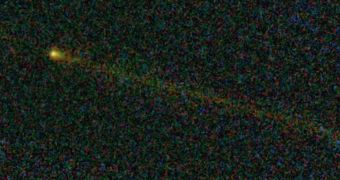A recent analysis of the comet Hartley 2, conducted with a NASA telescope, reveals that the object is shedding large amounts of ice particles, which aggregate to form golf ball-sized pebbles in its wake.
This was first discovered in late 2010, when a NASA space probe flew very close to the object. At that time, the investigations team controlling the spacecraft announced that it managed to identify patches of ice particles that were as big as basketballs.
Now, using data provided by the NEOWISE mission, scientists determined that the pebbly trail Hartley 2 leaves behind extends for long distances, as the object circles around the Sun. This NASA mission is an extension of the Wide-field Infrared Survey Explorer (WISE).
The initial science mission the observatory was supposed to carry out concluded after the liquid coolant aboard the spacecraft ran out. This rendered two of its four infrared light detectors useless for the type of science the telescope was built to conduct.
In the end, experts at the agency decided to extend this mission for a little bit, but focused the telescope on analyzing asteroids and comets, alongside near-Earth objects (NEO) that could pose a hazard to our planet.
In the case of Hartley 2, the original readings were collected by the EPOXI mission, which flew by the comet on November 4, 2010. This flight was carried out with the existing Deep Impact spacecraft, which has since been decommissioned.
NEOWISE observations also indicate that the comet is continuously expelling carbon dioxide gas jets, even as it flies some 2.3 AU (astronomical units) away from the Sun. An AU is roughly equal to 93 million miles.
“We were surprised that carbon dioxide plays a significant role in comet Hartley 2's activity when it's farther away from the Sun,” explains researcher James Bauer, who is the lead author of the new study.
Details of the work appear in the latest issue of the esteemed Astrophysical Journal. The WISE mission is managed by experts at the NASA Jet Propulsion Laboratory (JPL), in Pasadena, California.

 14 DAY TRIAL //
14 DAY TRIAL //